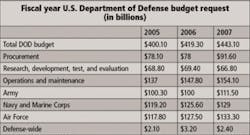By John Keller
WASHINGTON - Leaders of the U.S. Department of Defense (DOD) are proposing a 7.8 percent spending increase for procurement and research in communications, electronics, and intelligence in fiscal year 2006, compared with spending for the same accounts this year.
The $29.67 billion 2006 spending proposal for communications, electronics and intelligence (CE&I) does not include electronics-heavy activities such as avionics, vetronics, and missile guidance; when these are added, DOD electronics and optoelectronics spending next year could approach $58 billion to $60 billion. The DOD’s current-year spending for CE&I procurement and research is $27.37 billion.
Proposed CE&I spending represents 7 percent of the overall DOD 2006 funding request of $419.3 billion. Experts estimate that total DOD electronics, optoelectronics, and information technology spending is roughly 15 percent of the Pentagon’s total budget.
The DOD budget request for 2006 overall is $419.3 billion, up nearly 4.6 percent from current-year spending levels of $400.1 billion, and includes proposed spending for military personnel, military construction, and family housing. These numbers do not include supplemental congressional appropriations to fund the war in Iraq.
Air Force spending
The U.S. Air Force, which by far spends the most of any U.S. military service on electronics and optoelectronics, is proposing a $9.77 billion 2006 budget for CE&I procurement and research - a 4.6 percent increase over current-year spending of $9.32 billion.
Highlights of the Air Force’s technology procurement requests include $374.9 million for base information infrastructure; $131 million for tactical communications and electronics equipment; and $76.8 million for improvements to theater air-control systems.
Air Force researchers next year are proposing $835.8 million to develop the Transformational Satellite Communications system, otherwise known as TSAT; $665.3 million on the Advanced Extremely High Frequency Military Satellite Communications system; and $124.3 million on the Joint Tactical Radio System.
In other procurement programs where electronics and optoelectronics will play major roles, the Air Force in 2006 plans to spend:
- $3.5 billion to buy 15 C-17 airlifter aircraft;
- $3.2 billion to purchase 24 F/A-22 Raptor advanced tactical jet fighter-bombers;
- $851 million to buy nine Predator unmanned aerial vehicles (UAVs);
- $381 million for modifications to the F-16 jet fighter;
- $327.7 million to buy five Global Hawk UAVs;
- $260.8 million for modifications to the C-17A airlifter;
- $202.7 million for modifications to the T-38 Talon supersonic jet trainer;
- $185.7 million for modifications to the C-130 utility turboprop; and
- $145 million for modifications to the B-52 bomber.
- In other research and development programs where electronics and optoelectronics will play major roles, the Air Force in 2006 plans to spend:
- $2.47 billion on the Joint Strike Fighter;
- $756.3 million on the Space Based Infrared System High
- $350.1 million on the Joint Unmanned Combat Air System;
- $323.7 million on the National Polar-Orbiting Operational Environmental Satellite system;
- $308.5 million on the Global Hawk UAV
- $225.8 million on space-based radar;
- $122.2 million on the Fighter Tactical Data Link;
- $138.5 million on mission planning systems;
- $121.6 million on the Airborne Warning and Control System; and
- $87.4 million on the NAVSTAR III global positioning system.
Navy spending
The U.S. Navy is proposing to spend $3.07 billion next year on CE&I procurement and research - a 10.7 percent increase over current-year spending of $2.74 billion.
Highlights of the Navy’s technology procurement requests include $66 million for intelligence support equipment; $33.5 million for fire-support systems; and $14.8 million to buy and deploy the Joint Tactical Radio System.
Navy researchers next year are proposing to spend $542 million on atellite communications; $88.1 million on the Cooperative Engagement capability system; and $54.3 million on the Distributed Surveillance System.
In other procurement programs where electronics and optoelectronics will play major roles, the Navy in 2006 plans to spend:
- $2.7 billion for 38 F/A-18 Hornet jet fighter-bombers;
- $1.6 billion for one Virginia-class attack submarine;
- $993 million for nine V-22 Osprey tiltrotor aircraft;
- $422.4 million for modifications to the F/A-18 aircraft;
- $353.4 million to buy 379 Tomahawk cruise missiles;
- $254 million for ship communications automation;
- $226.9 million for submarine acoustic systems;
- $214.2 million for common avionics changes;
- $211 million for two E-2C Hawkeye early warning patrol aircraft;
- $138.2 million for attack submarine combat control systems;
- $127.4 million for submarine communications equipment;
- $96.2 million for the Information Systems Security Program;
- $91.5 million for Global Command and Control System-Maritime equipment;
- $76.6 million for submarine periscopes and imaging equipment;
- $65.3 million for the Fixed Surveillance System; and
- $48.6 million for common computer resources.
In other research and development programs where electronics and optoelectronics will play major roles, the Navy in 2006 plans to spend:
- $2.4 billion on the Joint Strike Fighter;
- $1.1 billion on SC-21 total ship systems engineering;
- $629.7 million on the Advanced Hawkeye maritime surveillance aircraft system;
- $542 million on space-based satellite communications;
- $409.1 million on the EA-18 electronic warfare jet aircraft;
- $250.8 million on the Joint Tactical Radio System-Navy;
- $237.1 million for Marine Corps communications systems;
- $163 million for advanced submarine systems development;
- $133.6 million for the Aerial Common Sensor;
- $121.3 million on the Cobra Judy ship-based missile-defense radar system;
- $99.3 million on tactical unmanned aerial vehicles;
- $90.8 million for improvements to the High-Speed Anti-Radiation Missile;
- $60.9 million for information technology development;
- $10 million for the Tactical Air Directional Infrared Countermeasures (TADIRCM) system; and
- $2.2 million on Navy tactical computer resources.
Army spending
The U.S. Army is proposing to spend $2.73 billion next year on CE&I procurement and research - a 1 percent decrease over current-year spending of $2.76 billion.
Highlights of the Army’s technology procurement requests include $122.4 million on the Warfighter Information Network-Tactical program; $294.4 million on a program to modify the Installation Information Infrastructure program; $146.1 million on the Force-21 Battle Command Brigade & Below program; and $164.7 million on night- vision devices.
Army researchers next year are proposing to spend $131.1 million to help develop the Warfighter Information Network-Tactical program; $156.7 million on the Joint Tactical Radio system; and $393.1 million on command, control, and communications systems.
In other procurement programs in whiche electronics and optoelectronics will play major roles, the Army in 2006 plans to spend:
- $878.4 million for 240 Stryker combat vehicles;
- $580.4 million for modifications to the AH-64 Apache attack helicopter;
- $489.7 million for the Patriot missile system;
- $449.67 million for the Family of Medium Tactical Vehicles;
- $443.5 million for modifications to t he M1 Abrams main battle tank;
- $211.2 million for amplified spontaneous emission (ASE) infrared countermeasures;
- $152.3 million for automated data processing equipment;
- $106.1 million for airborne avionics;
- $83.7 million for the Night Vision Thermal Weapon Sight;
- $57.6 million for the Javelin anti-tank missile;
- $55.5 million for the Single Channel Ground and Airborne Radio System (SINCGARS);
- $49.6 million for the Maneuver Control System;
- $41.3 million for the Bridge to Future Networks program; and
- $12.7 million for the Lightweight Laser Designator and Rangefinder.
In other research and development programs where electronics and optoelectronics will play major roles, the Army in 2006 plans to spend:
- $3.4 billion for the Future Combat System (FCS);
- $2.3 billion for the Armored Systems Modernization program;
- $409.1 million for aircraft modifications and product-improvement programs;
- $393.1 million for command, control, and communications systems;
- $139.6 million for tactical unmanned aerial vehicles;
- $91.6 million for distributed common ground and surface systems;
- $66.9 million for Army Tactical Command & Control hardware and software;
- $64.9 million for combat vehicle and automotive technology;
- $63.7 million for information technology development;
- $51.8 million for advanced night vision technology;
- $46.1 million for Firefinder radar development;
- $45.3 million on advanced electronic warfare technology;
- $42.5 million for advanced tactical computer science and sensor technology; and
- $39.6 million for electronics and electronic devices.
Defense agencies
The Missile Defense Agency (MDA), which is responsible for research into future generations of ballistic missile defense, is proposing a 2006 budget of $7.78 billion, an 11.4 percent decrease from 2005 levels of $8.78 billion.
Among MDA’s budget proposals are: $3.3 billion for ballistic missile defense midcourse defense segment; $1.4 billion for ballistic missile defense terminal defense segment; $529.8 million for ballistic missile defense sensors; $483.9 million for ballistic missile defense boost defense segment; $229.7 million for ballistic missile defense system interceptor; and $9.8 million for a medical free-electron laser.
The Defense Advanced Research Projects Agency (DARPA) is proposing a 2006 budget of $3.1 billion, up 3.9 percent from this year’s level of $2.98 billion.
Among DARPA’s budget proposals are: $198.8 million for information and communications technology; $200.8 million for cognitive computing systems; $214.4 million for advanced electronics technologies; $216.4 million for command, control, and communications systems; and $139.1 million for land warfare technology.
The Defense Information Systems Agency (DISA) proposes a 2006 procurement and research budget of $511.3 million, a 15.4 percent increase from this year’s level of $432.7 million.
The U.S. Special Operations Command’s combined procurement and research budget for next year is $1.72 billion, a decrease of 7 percent from this year’s level of $1.85 billion.




